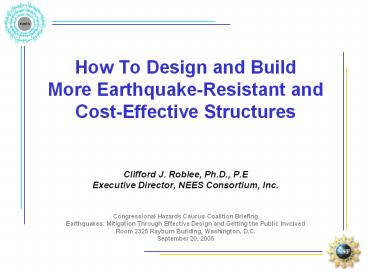How To Design and Build More Earthquake-Resistant and Cost-Effective Structures - PowerPoint PPT Presentation
Title:
How To Design and Build More Earthquake-Resistant and Cost-Effective Structures
Description:
How To Design and Build More Earthquake-Resistant and Cost-Effective Structures Clifford J. Roblee, Ph.D., P.E Executive Director, NEES Consortium, Inc. – PowerPoint PPT presentation
Number of Views:204
Avg rating:3.0/5.0
Title: How To Design and Build More Earthquake-Resistant and Cost-Effective Structures
1
How To Design and Build More Earthquake-Resistant
and Cost-Effective Structures
- Clifford J. Roblee, Ph.D., P.E
- Executive Director, NEES Consortium, Inc.
- Congressional Hazards Caucus Coalition Briefing
- Earthquakes Mitigation Through Effective Design
and Getting the Public Involved - Room 2325 Rayburn Building, Washington, D.C.
- September 20, 2005
2
Earthquake Risk is Well Recognized by Experts,
But Often Overlooked by Public Until It Is Too
Late
NHK Nagoya Office, Kobe, Japan, January 17, 1995
Courtesy Paul Somerville, URS
There Is No Radar, No Intelligence, For
Short-Term Warning Just Assurance of Long-Term
Occurrence
3
Earthquake Risk is Well Recognized by Experts,
But Often Overlooked by Public Until It Is Too
Late
4
Perspective EQ Risk Mitigation
- Engineering/Construction of Resilient
Infrastructure is Best Mitigation Strategy - Complements Land Use, (Potential) Early Warning,
and Emergency Response Strategies - 100 Effectiveness is Technically Feasible
Issues Surround Cost-Effectiveness - Success Requires
- Effective Design Tools for Hazard Identification
- Cost-Effective Engineering Solutions for Varied
- Performance Objectives (Life Safety, Post-EQ
Functionality, Life-Cycle Costs, etc.) - Hazard Types (Shaking, Fault Offset,
Liquefaction, Landslide, Tsunami) and Levels of
Hazard - Infrastructure Types (Buildings, Bridges,
Lifelines, Dams, etc.) - Construction Materials (Steel, Concrete, Timber,
Soil, etc.) - Construction Methods (Cast-in-Place, Pre-Fab
Components, etc.) - Political Skill Will
- Public-Interest Policies Decisions (Market
Alone Insufficient) - Smart Codes Design Practices Applied by
Knowledgeable Workforce - Good Construction Maintenance Practices
5
Much Has Been Accomplished
6
... and Continues To Be Accomplished
Courtesy of University of Nevada, Reno
7
... and Continues To Be Accomplished
Courtesy of University of Nevada, Reno
8
Much Still Remains To Be Done
- Extreme Loading Conditions
- Near-Fault Directivity
- Fault Crossing Large Offset
- Liquefaction Lateral Spread
- Landslide
- Performance-Based Design
- Quantitative Risk Assessment
- Account for Variability Uncertainty
- Multiple Performance Objectives
- Cost-Effectiveness
- Socio-Economic Impact
- System Network Functionality
- Consequences on Commerce/Individuals/Society
- Innovative Technologies
- Devices Base Isolation, Energy Absorption, etc.
- Details Materials, Connections, Systems, etc.
- Post-Yield Behavior
- Highly Non-Linear Problem
- Controlled Sequence of Yield
- Requires Large-Scale Testing
- Reliable Simulation
- System vs. Component Performance
- Compounding Error Uncertainty
- Fault-to-Rebar for Variability
9
Advancing EQ-Resilient Infrastructure
- Why Accelerate Innovation?
- 100s Billions in Annual US Construction in
Seismic Areas - Typical Infrastructure Design Life 30-100 Years
- Retrofit is More Costly and Less Effective Than
New Construction
- The Innovation Process (10-30 Years)
- Basic Research Ideas Discovery of Fundamental
Concepts/Techniques - Applied Research (Development) Evaluation,
Testing, Refinement, Design Models - Verification Prototype/Trial Applications
Monitoring, Pre-Guidelines - Professional Acceptance Adoption Code
Standards Development - Deployment Routine Application by Stakeholders
- Whats Needed to Accelerate Innovation?
- Strategic Plan for Research (including
Development) - Balanced Portfolio of Basic and Applied Research
- Stakeholder Involvement in Both Planning and
Guiding Research - Advanced Testing Facilities Knowledgeable
Researchers (e.g. NEES) - Political Will (Public Support ) for
Research thru Deployment
10
Example Verification to DeploymentInnovative
Bridge Application of Very Large Friction
Pendulum Bearings
Courtesy of Caltrans
11
NEES Shared-Use Infrastructure
12
Example Applied Engr. ResearchExperimental
Validation Refinement of Zipper Frame System
Concept
Courtesy of Prof. Roberto Leon, Georgia Tech.
13
NEES Testing of Zipper Frame
Courtesy of Prof. Roberto Leon, Georgia Tech.
14
NEES Testing of Zipper Frame
Courtesy of Prof. Andrei Reinhorn University of
Buffalo
15
NEES Testing of Zipper Frame
Courtesy of Prof. Andrei Reinhorn University of
Buffalo
16
Closing Perspective
- We are not about to predict earthquakes. As one
door closes, another opens. If we cant predict
earthquakes, then lets learn to live safely with
them. - Isnt it better if we can build buildings that
dont fall down. Then, rather than try to
evacuate populations and then come back to a
destroyed city, we dont have to leave, and our
cities survive. It seems to me that this really
is the best solution, and the way to do that is
to begin to identify buildings that are collapse
risks and begin to improve them or get rid of
them. - Dr. Ross Stein, Geophysicist, USGS Menlo Park
- Science Friday Interview, June 24, 2005































